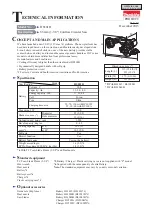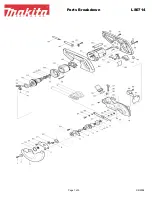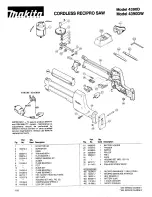
9
CUTTING PICTURE FRAMES, SHADOW BOXES AND OTHER
FOUR-SIDED PROJECTS
To best understand how to make the items listed here, we suggest that
you try a few simple projects using scrap wood until you develop a
“FEEL” for your saw.
Your saw is the perfect tool for mitering corners like the one shown in
Figure 13. Sketch A in Figure 12 shows a joint made by using the bevel
adjustment to bevel the edges of the two boards at 45 degrees each to
produce a 90 degree corner. For this joint the miter arm was locked in the
zero position and the bevel adjustment was locked at 45 degrees. The
wood was positioned with the broad flat side against the table and the
narrow edge against the fence. The cut could also be made by mitering
right and left with the broad surface against the fence.
CUTTING TRIM MOLDING AND OTHER FRAMES
Sketch B in Figure 12 shows a joint made by setting the miter arm at
45 degrees to miter the two boards to form a 90 degree corner. To make
this type of joint, set the bevel adjustment to zero and the miter arm to
45 degrees. Once again, position the wood with the broad flat side on the
table and the narrow edge against the fence.
The two sketches in Figure 12 are for four-side objects only.
As the number of sides changes, so do the miter and bevel angles. The
chart below gives the proper angles for a variety of shapes.
(The chart assumes that all sides are of equal length.) For a shape that is
not shown in the chart, use the following formula. 180 degrees divided
by the number of sides equals the miter (if the material is cut vertically)
or bevel angle (if the material is cut laying flat).
- EXAMPLES -
NO. SIDES
ANGLE MITER OR BEVEL
4
45°
5
36°
6
30°
7
25.7°
8
22.5°
9
20°
10
18°
CUTTING COMPOUND MITERS
A compound miter is a cut made using a miter angle and a bevel angle at
the same time. This is the type of cut used to make frames or boxes with
slanting sides like the one shown in Figure 14.
NOTE:
If the cutting angle varies from cut to cut, check that the bevel
clamp knob and the miter lock knob are securely tightened. These knobs
must be tightened after making any changes in bevel or miter.
The chart shown on page 13 will assist you in selecting the proper bevel
and miter settings for common compound miter cuts. To use the chart,
select the desired angle “A” (Figure 14) of your project and locate that
angle on the appropriate arc in the chart. From that point follow the chart
straight down to find the correct bevel angle and straight across to find
the correct miter angle.
Set your saw to the prescribed angles and make a few trial cuts. Practice
fitting the cut pieces together until you develop a feel for this procedure
and feel comfortable with it.
Example:
To make a four-sided box with 26° exterior angles (Angle A,
Figure 14), use the upper right arc. Find 26° on the arc scale. Follow
the horizontal intersecting line to either side to get miter angle setting on
saw (42°). Likewise, follow the vertical intersecting line to the top or bottom
to get the bevel angle setting on the saw (18°). Always try cuts on a few
scrap pieces of wood to verify settings on saw.
VERNIER SCALE
Your saw is equipped with a vernier scale for added precision. The vernier
scale allows you to accurately set miter angles to the nearest 1/4 degree.
To use the vernier scale follow the steps listed below.
(As an example, let’s assume that the angle you want to miter is
24-1/4 degree right).
1. Turn off miter saw.
2. Set the miter angle to the nearest whole degree desired by aligning
the center mark in the vernier scale, shown in Figure V1, with the
whole degree number etched in the miter scale. Examine Figure V2
closely; the setting shown is 24 degrees right miter.
3. To set the additional 1/4 degree, squeeze the miter arm lock and
carefully move the arm to the RIGHT until the 1/4 degree vernier
mark aligns with the CLOSEST degree mark on the miter scale. In our
example, the closest degree mark on the miter scale happens to be
25 degrees. Figure V2 shows a setting of 24-1/4 degrees right miter.
For settings that require partial degrees (1/4, 1/2, 3/4 degrees) align the
desired vernier mark with the CLOSEST degree mark on the miter scale,
as described below (The plastic vernier plate is inscribed with marks for
1/4, 1/2, 3/4 and 1 degrees. Only the 1/2 degree and the 1 degree are
numerically labeled.)
WHEN MITERING TO THE RIGHT
To increase the miter angle when mitering to the right, move the arm to
align the appropriate vernier mark with the closest mark on the miter
scale to the right. To decrease the miter angle when mitering to the right,
move the arm to align the appropriate vernier mark with the closest mark
on the miter scale to the left.
WHEN MITERING TO THE LEFT
To increase the miter angle when mitering to the left, move the arm to
align the appropriate vernier mark with the closest mark on the miter
scale to the left. To decrease the miter angle when mitering to the left,
move the arm to align the appropriate vernier mark with the closest mark
on the miter scale to the right.
CUTTING BASE MOLDING
ALWAYS MAKE A DRY RUN WITHOUT POWER BEFORE MAKING ANY
CUTS.
Straight 90 degree cuts:
Position the wood against the fence and hold it in place as shown in
Figure 15. Turn on the saw, allow the blade to reach full speed and
lower the arm smoothly through the cut.
CUTTING BASE MOLDING UP TO 25.4mm (1") THICK BY UP TO 91mm
(3-5/8") WIDE VERTICALLY AGAINST THE FENCE
• Position molding as shown in Figure 15
• All cuts made with the back of the molding against the fence and
bottom of the molding against the base
INSIDE CORNER:
Left side
1. Miter left 45°
2. Save left side of cut
Right side
1. Miter Right 45°
2. Save right side of cut
IMPROPER CUT
PROPER CUT
FIG. 11
FIG. 11A


































